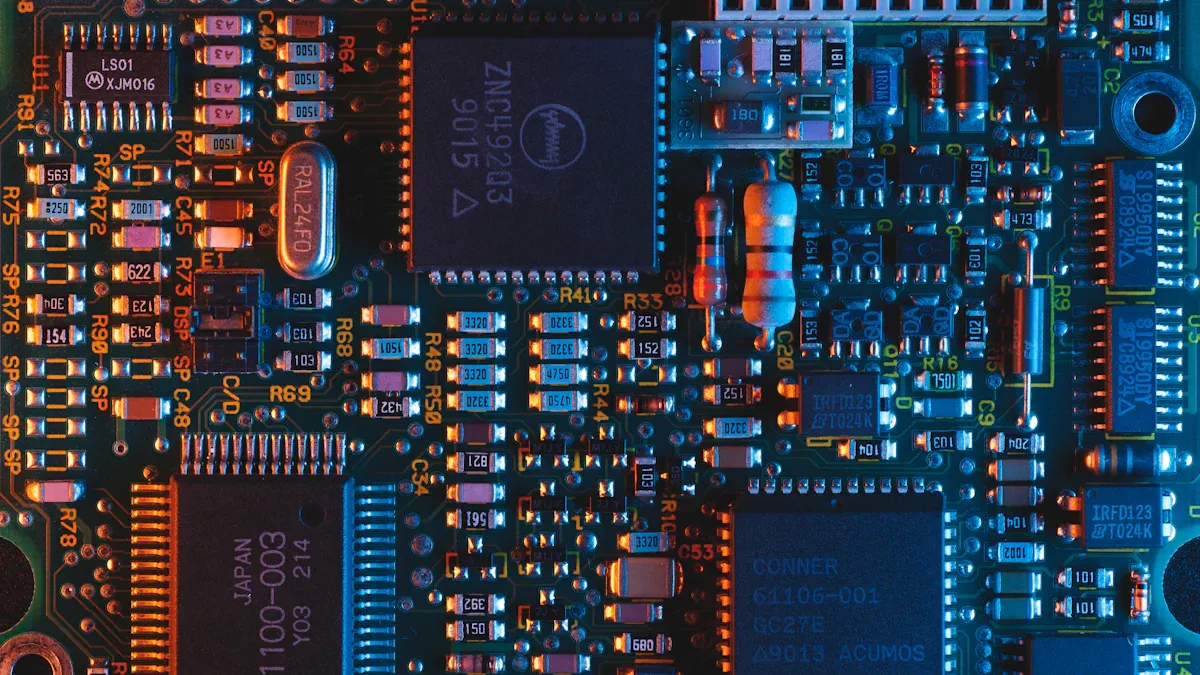Emerging Trends in Radar Signal Processing Chip Technologies

Radar signal processing chips are changing how we use technology every day. These chips, using tools like AI and digital processing, now manage huge data amounts with great accuracy.
They are bringing new ideas to important areas:
Cars use them for crash prevention and smart cruise control.
Airplanes use them for better pictures and navigation.
The military uses them to block signals and stay aware.
In 2022, Infineon Technologies made the first 77 GHz radar signal processing chip for cars.
Using 28-nm CMOS tech, the RASIC CTRX8181 made signals clearer and systems better.
These improvements make radar signal processing chips work smarter for new uses.
With these changes, radar signal processing chip technology is improving industries and raising performance standards.
Key Takeaways
Radar chips are changing industries like cars, planes, and defense. They make things safer and work better.
AI and machine learning help radar find signals faster and block interference.
Smart antennas, using AI, make radar more accurate in tricky places like cities.
MIMO and beamforming make radar sharper and more useful for things like driverless cars.
Future radar will save energy and grow to meet industry needs.
AI and ML in Radar Signal Processing Chips
AI (Artificial Intelligence) and ML (Machine Learning) are changing radar chips. These tools make systems smarter, faster, and more dependable. Let’s see how they improve radar technology.
Better Signal Detection and Sorting
AI and ML help radars find and sort signals better. They quickly study lots of data to spot patterns missed before. For example:
AI finds weak signals even in noisy places.
ML sorts radio signals more accurately than older methods.
These tools handle tricky areas, like cities, by fixing signal issues.
This makes radars work well, even in tough spots. Whether for cars or planes, AI and ML make radar systems more trustworthy.
Fighting Signal Jamming
Jamming can mess up radar, but AI and ML stop it. They help radar chips notice and adjust to jamming fast. AI studies signals to tell real ones from fake ones. This is very important for defense systems to keep working.
You see this in daily life too. Car radars use AI to work smoothly, even with interference. This makes radars safer and more reliable in many fields.
Fast Data Processing
AI and ML handle data super fast. Radars create lots of information, and these tools analyze it instantly. This is key for things like self-driving cars, where quick decisions save lives.
AI-powered radar chips process sensor data quickly for faster reactions. For example, in cars, AI spots obstacles, predicts moves, and adjusts driving. This quick processing boosts safety and radar performance.
With AI and ML, radar chips are better than ever. They improve detection, stop jamming, and speed up data work. As these tools grow, radar systems will keep getting smarter and more advanced.
Improvements in Antenna Technology for Radar Signal Processing Chips
Smarter Antenna Arrays with AI
AI is making antennas smarter and more adaptable. These antennas change how they work based on their surroundings. AI studies signals and adjusts antennas to improve radar systems. They focus on important signals and ignore unnecessary noise. This helps radars work better and more accurately.
Machine learning helps antennas choose the best settings. It uses past data to predict what works best next time. For example, in busy cities, AI antennas reduce signal problems and make signals clearer. This makes radar systems reliable, even in tough places.
Uses in Car Radar Systems
New antenna technology is improving car radar systems. These systems use special antennas to find objects and keep people safe. AI and ML make these antennas more precise. Cars can spot dangers and react quickly.
Testing methods like HiL and ViL check if these systems work well. They create fake driving situations to test radar safety features. Radar simulators make testing easier by creating fake objects without moving cars.
Testing Type | What It Does |
|---|---|
Checks radar safety features in fake scenarios. | |
Electronically steerable antenna arrays | Simulates radar objects without moving cars. |
Radar target simulators | Tests cars in tricky situations. |
These upgrades make car radar systems safer and more dependable.
Impact on Mobile and IoT Devices
Antennas are also improving mobile and IoT devices. AI antennas make connections stronger, even in weak signal areas. This is important for IoT devices that need constant communication to work.
In phones, AI and ML help networks run better by fixing signal issues. Antennas adjust to what users need, giving faster and stronger connections. This helps smart homes, wearable tech, and factory IoT devices stay connected.
AI and ML are pushing antenna technology forward. Whether in cars or IoT devices, these changes make radar chips work better and smarter.
MIMO and Beamforming Innovations in Radar Signal Processing Chip Design

Making Radar Systems Better
MIMO (Multiple Input Multiple Output) and beamforming are improving radar systems. MIMO uses many antennas to send and receive signals. This helps radars find objects more precisely. Beamforming directs radar energy to specific areas. It makes signals clearer and reduces unwanted noise. Together, these technologies help radars track objects in busy places.
Passive radar systems now use illuminators of opportunity (IoO). These help detect objects that don't send signals back. By combining signals from different antennas, radars can find objects better. But challenges like signal interference and antenna setup still need solving.
Feature | Details |
|---|---|
Focus | |
Application | Passive radar uses IoO to find objects that don't cooperate. |
Benefits | Better object detection by combining signals from antennas. |
Challenges | Signal interference and antenna setup need more research. |
Beamforming for Better Accuracy
Beamforming helps radars find objects more accurately. It uses many antennas and millimeter waves to locate signals. This reduces signal loss and improves radar precision. New algorithms like Quantum Support Vector Machine and Sparse Bayesian Learning make beamforming even better in tricky situations.
Digital beamforming works directly with hardware, making it faster. This speed is important for things like self-driving cars and air traffic control. It helps radars process data quickly and efficiently.
Evidence Description | Key Points |
|---|---|
Uses many antennas and millimeter waves to locate signals better. | |
Faster data processing | Works directly with hardware for quicker operations. |
Advanced algorithms for signal location | Includes Quantum Support Vector Machine and Sparse Bayesian Learning for tough conditions. |
Making Systems Scalable and Efficient
Modern radar chips need to be scalable and efficient. Metrics like EIRP, SNR, and EIS measure how well they work. Higher EIRP means stronger signals for longer distances. Better SNR ensures clear communication. Improved EIS helps radars stay connected in hard conditions.
These metrics make radar systems work better in many areas. For example, car radars use these improvements to detect objects faster and keep people safe.
Metric | Description | Impact on Scalability and Efficiency |
|---|---|---|
EIRP | Measures total power sent by an antenna. | Stronger signals for longer distances and better performance. |
SNR | Measures signal quality. | Clearer communication and faster data rates. |
EIS | Measures minimum signal strength needed. | Keeps connections strong in tough conditions. |
MIMO and beamforming are changing radar technology. They make radars more accurate, scalable, and efficient. These advancements are shaping the future of radar systems.
Future Uses and Problems in Radar Signal Processing Chip Technologies
New Uses in Self-Driving Cars
Radar chips are changing how cars drive and stay safe. These chips help cars avoid crashes and drive automatically. They are key for spotting objects, checking blind spots, and staying safe in bad weather.
Radar works well when cameras or LiDAR fail. For example, rain or fog can block a camera’s view. Radar still finds objects clearly in these conditions. Reports like "Autonomous Driving Sensor Chip Market" show radar is vital for self-driving cars. Another report, "Automotive Radar Market 2025-2045," predicts radar will grow in robotaxis and future car systems.
Report Name | Main Points |
|---|---|
Autonomous Driving Sensor Chip Market | Radar improves safety and reliability in self-driving cars. |
Automotive Radar Market 2025-2045 | Radar is important for robotaxis and advanced car systems. |
New ideas like sparse sensing make radar better in cars. These methods use smart designs to detect objects more efficiently. Future cars will be safer and more accurate thanks to these improvements.
Uses in Military and Space
Radar chips are also important for military and space systems. These areas need radars that process data fast and find threats quickly. Materials like Gallium Nitride (GaN) and Silicon Carbide (SiC) make radars work better at high frequencies.
Military radars now use AI and ML to improve. AI helps radars adjust to new situations. ML makes it easier to recognize and classify targets. For example, smart radars learn from their surroundings and change how they work. This is crucial for modern defense, where threats change quickly.
Big improvements in military and space radars include:
GaN and SiC materials for better high-frequency performance.
AI and ML for faster data processing.
More demand for advanced radar systems in defense.
These upgrades make radars reliable in tough environments. They are essential for national safety and space exploration.
Solving Power and Growth Problems
Advanced radar systems need to save power and grow easily. Modern radar chips must work at high frequencies, like 140 GHz, while using less energy. Solutions like system-on-chip designs and tiny components help achieve this.
Feature | Details |
|---|---|
Frequency | 140 GHz |
Technology | Uses CMOS technology |
Power Saving | Improved with system-on-chip designs and tiny components. |
Growth | Uses current tech to lower costs and expand production. |
Problem | Hard to balance power needs at higher frequencies. |
AI helps radars use less power by adjusting operations smartly. Special hardware also speeds up radar processing while saving energy. These changes make radars cheaper and better for the environment.
Challenges still exist. Making radars that grow easily and work for many uses needs more research. But with new ideas and studies, radar systems will keep improving in power and growth.
Radar signal chips are changing how industries work and grow. New ideas like AI, MIMO, and beamforming make radars more accurate and efficient. These changes help in many areas, like self-driving cars and defense.
Better digital and RF/microwave tech has made radars useful in business.
The Model 5560 processes data faster, using less power—63% less!
Modern radars now update quickly, leading to smarter, flexible systems.
These upgrades improve safety in cars, planes, and national defense. As radars improve, they will become smarter and more helpful in daily life.
FAQ
1. How are radar chips unique compared to other chips?
Radar chips are made to find objects and patterns in signals. They work faster and more accurately than regular chips, even in tough conditions like fog or interference.
2. How does AI make radar systems better?
AI helps radar find weak signals and cut down on noise. It also adjusts to interference, making radar systems smarter and quicker for things like self-driving cars.
3. Can radar chips handle bad weather?
Yes, radar chips work well in rain, fog, and snow. They use advanced tools to find objects when cameras or LiDAR can't, keeping systems reliable.
4. Are radar chips good at saving energy?
Modern radar chips are designed to use less power. They combine smart designs and AI to work efficiently while saving energy.
5. Which industries benefit most from radar chip improvements?
Cars, defense, airplanes, and smart devices gain the most. Radar chips make driving safer, improve navigation, and help devices stay connected.
See Also
New Developments in Automotive Chip Technology for Future Needs
Leading Advancements in Medical Imaging Chips for 2025
Current Trends Influencing the Analog Integrated Circuit Market
